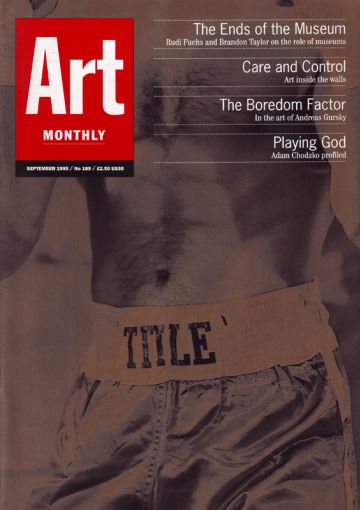Feature
The Ends of the Museum
Brandon Taylor muses on the museum of the future
The art museum today might be said to evoke two extreme responses. In the first, it functions as a container and display-case for all that is best in contemporary culture, including its display and validation of the art of the past. Managed by an educational and social meritocracy, the museum presents human artefacts as a stimulus to sustained reflection upon, and aesthetic pleasure in, the life of forms, their references and interrelations.
Through that display it develops the most challenging interpretations of those objects for both a general and specialised public, one moreover that has expanded exponentially in the past 25 years to turn museum visiting into an activity capable even of supplanting TV, sport and royal family-watching as major social pastimes. Within this expanding network, the museum of contemporary art presents an ever-changing spectacle of experimentation in the production and understanding of material life. Other forms of speculation, such as academic philosophy and even the novel, wither under the impact of such an onslaught. From remote beginnings in the 18th Century, the public art museum now turns its final trick, in the form of the seduction of the global corporation eager to invest its unpopular profits in the fastest expanding up-market participation activity in the world. Somewhere near the beginning of the 21st Century, the art museum finally comes of age.
According to the second response, the art museum functions precisely as the inverse and antithesis of the idea of participatory and democratic culture. Perpetually stifled by its domination by an unrepresentative social elite and still managed according to patterns derived from a long-declining European aristocracy, the museum abstracts and artifically sanctifies objects by presenting them, fetishised by quasi-religious forms of lighting and display, as objects of veneration and specular fascination to an already alienated audience of passive culture-tourists. Further, both the old master and contemporary art museum function as reactionary support-bases for a continuing phallocentric culture covertly dedicated to Western hegemony in general and the marginalisation of the cultures of economically weaker or colonised nations in particular. Propped up increasingly by the investment strategies of dubious multi-national corporations aimed at the final domination and passivisation of populations, museums today find themselves inextricably implicated in patterns of inequality and their reproduction unmatched throughout the globe.
At the risk of some over-simplification, it may be said that the space between these responses, and the processes of moving between them, are those of much contemporary soi-disant avantgardist art. The artist conceives of the museum as corrupt: then moves to fill it with something better. The artwork takes issue with the presuppositions of all museums, but occupies its spaces in the apparently confident expectation that by doing so the world can be saved. In the special form taken by the ensemble known as the installation, the artwork takes the museum space itself as something to be directly altered, hence demonstrating that even the hallowed distinction between context and object can be overcome, and with it, of course, the aura of the museum and the art-object itself.
Something like this caricature can be applied to much that was displayed recently at ‘The End(s) of the Museum’ exhibition at the Tapies Foundation in Barcelona: a resonant space, for reasons that will become apparent. Take the work of smearing per- formed by Janine Antoni. The artist dips her attrac- tive long hair into a bucket of Loving Care hair dye and, dressed in a body-hugging cat-suit, defiles the space of the gallery with loops of barely-controlled waves of uniform, darkish colour. The space is then roped off to visitors, who can only peer in meekly. Here are the familiar marks of contemporary protest: the artificially proscribed body, the disenfranchised female artist, the fecal smear. Art that is not an object
There are other cases in which the artist intro- duces something supposedly scandalous into the space of the museum, in such a way that by doing so the museum is caught between the contradictions of its own complicity in the scandal and the pretensions of its larger mission. Julia Scher relays video pictures from a nearby mental institution into the gallery, while pictures of the gallery’s office routines go back into the asylum. The Barcelona artist Muntadas gives us talking heads from the ‘art system’: dealers , collec- tors, curators, docents, critics, media types. Jamelie Hassan offers us the chance to discard a piece of rub- bish from our pockets in exchange for a free hairpin manufactured in Canton. In making a souvenir for the Western tourist, the street vendor reveals her position as exotic museal ‘other’. Boltanski piles up the belongings of a ‘Man from Barcelona between 1973 and 1995’. Sophie Calle gives us photographic records of stolen or missing art-works, or rather the places where they us ed to be. Andrea Fra ser ha s Tapies himself talking about the monographic muse- um in the exhibition lobby. The artist confronts the perceived exhaustion or duplicity of the museum with a work that then active ly seeks out the museum space as its natural or inevitable setting.
Looked at one way, the tendency followed obsessively in ‘The End(s) of the Museum’ exemplifies nothing more (though nothing less) than the self-critical impulse formerly monopolised by the modernist artwork now extended to the display machinery of the art museum itself. But a number of questions beg to be put. How does an evolving self-consciousness in the artwork really become compatible with the self-consciousness of the museum itself? Which is to say: would not a technically or stylistically self-critical artwork presuppose a normative, even conventional mise-en-scene of display? Isn’t the point lost, somehow, when the self-parodying, self-misunderstanding, artwork rubs up against, or is allowed to rub up against, a display-framework that is itself hell-bent on self-parody and self-misunderstanding?
The question leads to a second. The anxiety and self-reference of the artwork are extended to the museum: but by whom? One’s sense of recent history comes into play here. One is reminded that in Conceptual artworks of the later 1960s and early 1970s a real sense of contradiction attended certain rereadings of the gallery space as being hedged about with interests, given to commodification, elitism, and so on. Recall only Hans Haacke’s project at the Guggenheim Museum in 1971, in which he displayed publicly available records of real-estate holdings in the city; a work which was quickly rejected by the museum as incompatible with its larger mission of ‘pursuing aesthetic and educational objectives that are selfsufficient and without ulterior motive’. Or take Art and Language’s early Indexes, displayed in Kassel and London, which rescheduled the museum space as a reading room, discussion centre, or office. At this time, one could talk legitimately of a gap or caesura between the museum’s traditionally dominating values and those of the world-reforming or scandal-seeking artwork, as well as between Conceptual artists’ simultaneous deprecation of the museum alongside their continued deployment of it.
But in the 1990s it is the museum itself that invites the artist in, as agent, in effect, of its own anxious self-consciousness. Towards the end of a longer tradition of work which seeks to displace or redesign its own conditions of display, art that ‘addresses’ the museum now looks like becoming not a stylistic but a procedural genre all of its own. In the present case, the contemporary museum makes an awkward and difficult further step: it gathers in procedurally comparable projects and packages the whole into nothing less than what now looks like that genre’s final nadir and degeneration: the group show.
Particular irony attended ‘The End(s) of the Museum’ – a title itself quixotically derived from Derrida’s 1968 essay ‘Les fins de l’homme’ – in the form of a project of which it seemed largely unaware. In the area to the west of the old Plaça dels Angels in Barcelona there now stands Richard Meier’s vast new Museu d’Art Contemporani de Barcelona, shining white against the backdrop of the city’s inner-city tenements and apparently proclaiming to the world that the future lies not in the older patterns of urban living, or not only in those patterns – but in contemporary art. But the museum today stands empty, a monument less to hygiene and cost-efficiency as to the very real questions hanging over the uses of a contemporary museum in the centre of fiercely nationalistic international city. That seems to me to be an agenda of a very different order; it may yet also prove to be subject to invasion by the artist, not as exterior and independent assault-force, but as agent of the museum’s anxiety about itself.
‘End(s) of the Museum’ was at the Fundació Antoni Tàpies, Barcelona, from 14 March to 4 June 1995. A record of the symposium of the same title, held 16-18 May, edited by Thomas Keenan and John Hanhardt and containing papers by Andrew Ross, Gyan Prakash, Friedrich Kittler, Werner Hamacher, Kristin Ross and Alexander Garcla Duttmann, was published by the Fundació Antoni Tapies later in the year.
Brandon Taylor is the author of Art of Today, published by Weidenfeld and Nicholson in 1995.
First published in Art Monthly 189: September 1995.









